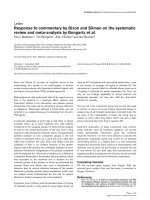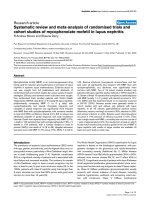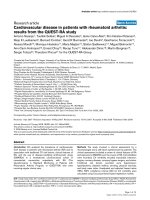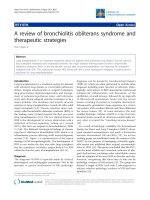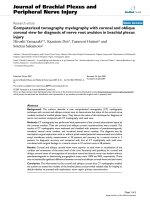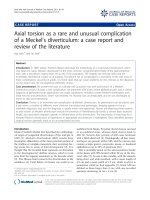Báo cáo y học: "Bench-to-bedside review: Sepsis, severe sepsis and septic shock – does the nature of the infecting organism matter" pdf
Bạn đang xem bản rút gọn của tài liệu. Xem và tải ngay bản đầy đủ của tài liệu tại đây (236.85 KB, 6 trang )
Page 1 of 6
(page number not for citation purposes)
Available online />Abstract
International guidelines concerning the management of patients
with sepsis, septic shock and multiple organ failure make no
reference to the nature of the infecting organism. Indeed, most
clinical signs of sepsis are nonspecific. In contrast, in vitro data
suggest that there are mechanistic differences between bacterial,
viral and fungal sepsis, and imply that pathogenetic differences
may exist between subclasses such as Gram-negative and Gram-
positive bacteria. These differences are reflected in different
cytokine profiles and mortality rates associated with Gram-positive
and Gram-negative sepsis in humans. They also suggest that
putative anti-mediator therapies may act differently according to
the nature of an infecting organism. Data from some clinical trials
conducted in severe sepsis support this hypothesis. It is likely that
potential new therapies targeting, for example, Toll-like receptor
pathways will require knowledge of the infecting organism. The
advent of new technologies that accelerate the identification of
infectious agents and their antimicrobial sensitivities may allow
better tailored anti-mediator therapies and administration of anti-
biotics with narrow spectra and known efficacy.
Introduction
Sepsis and its sequelae, namely severe sepsis, septic shock
and multiple organ failure, dominate the case load of non-
coronary intensive care units (ICUs). Despite a fall in
mortality, deaths attributable to sepsis have risen in
developed countries as the incidence increases in an ageing
population [1,2]. Moreover, patients who survive suffer
considerable morbidity and score poorly in many domains of
health-related quality of life assessments [3,4]. Hence, sepsis
is the focus of many quality improvement initiatives. The US
Institute for Healthcare Improvement’s ‘5 million lives’
campaign aims to reduce the incidence of nosocomial sepsis
[5]. Furthermore, the Surviving Sepsis Campaign (instigated
by the European Society of Intensive Care Medicine,
International Sepsis Forum and Society of Critical Care
Medicine) aims to harmonize the clinical management of
patients with established sepsis using the best evidence
available currently [6].
Louis Pasteur was the first to link micro-organisms with
human disease when he identified the streptococcal aetio-
logy of puerperal sepsis [7]. It is now known that sepsis also
arises after infections with a range of micro-organisms that
include viruses, fungi and protozoa. However, neither the
Surviving Sepsis Campaign nor the guidelines of the
American College of Chest Physicians and Society of Critical
Care Medicine [8] make any reference to whether specific
infectious agents influence the natural history or therapy of an
episode of sepsis. Similarly, standard definitions do not focus
on the site of infection. Thus, sepsis is often considered as a
single entity, with little or no reference to the causative agent
or the anatomical focus of infection. Does this mean that the
nature of the organism has no influence?
Clinically, the nature of the organism is critical in that many
possess specific virulence factors that have considerable
prognostic significance. For example, Panton-Valentine leuko-
cidin secreted by staphylococci contributes to the develop-
ment of a rapidly progressive haemorrhagic necrotizing
pneumonia in immunocompetent patients [9] and a particu-
larly high mortality rate [10]. It is likely that other microbial and
host factors influence the effects of Panton-Valentine
leukocidin [11,12]. Similarly, other bacterial subgroups
secrete toxins such as superantigenic toxic shock syndrome
toxin 1, exfoliative toxin, botulinum toxin and tetanus toxin. All
are associated with additional mortality above that
attributable to bacterial infection per se. However, aside from
virulence factors specific to certain organisms, differences
are also detectable in association with broader microbial
classifications. Most data exist for differences between Gram-
positive and Gram-negative infections [13].
Review
Bench-to-bedside review: Sepsis, severe sepsis and septic shock –
does the nature of the infecting organism matter?
Hongmei Gao, Timothy W Evans and Simon J Finney
Adult Intensive Care Unit, Royal Brompton Hospital, Sydney Street, London SW3 6NP, UK
Corresponding author: Timothy Evans,
Published: 6 May 2008 Critical Care 2008, 12:213 (doi:10.1186/cc6862)
This article is online at />© 2008 BioMed Central Ltd
ICU = intensive care unit; IFN = interferon; IL = interleukin; LPS = lipopolysaccharide; PCR = polymerase chain reaction; TLR = Toll-like receptor;
TNF = tumour necrosis factor.
Page 2 of 6
(page number not for citation purposes)
Critical Care Vol 12 No 3 Gao et al.
Differences in the host response
Infectious pathogens are detected by the innate immune
system via Toll-like receptors (TLRs). Ten TLRs have been
identified, through which most pathogens can be detected.
Recognition does not require previous exposure to a
pathogen or an enormous range of genome-encoded recep-
tors, such as is associated with the T-cell receptor. TLRs
respond to molecular patterns such as unmethylated CpG
dinucleotides that are common in bacteria but uncommon in
the host. Mammalian DNA methyltransferases result in
methylation of 70% to 80% of CpG cytosines [14]. Similarly,
TLR4 and TLR2 recognize lipopolysaccharide (LPS) and
lipoteichoic acid, structural molecules that are unique to the
cell walls of Gram-negative and Gram-positive bacteria,
respectively. Whereas bacterial components signal via a
single TLR, it is unlikely that whole bacteria signal so exclu-
sively. Indeed, cell wall extracts from Gram-positive and
Gram-negative organisms contain components that can
activate both receptors [15,16]. This lack of absolute
dependence on a single receptor has obvious benefits for the
host. However, mice deficient in TLR2 and TLR4 are more
prone to infections with staphylococci [17] and Salmonella
spp. [18], respectively, which suggests that Gram-positive
infection may have a TLR2-dominant signal, whereas Gram-
negative infections have a TLR4-dominant signal.
The intracellular signalling cascades of the TLRs are
illustrated in Figure 1. These converge through common
adaptor molecules onto three transcription factors: nuclear
factor-κB, activator protein-1, and interferon response factor-1.
All three factors result in the upregulation of genes for pro-
inflammatory cytokines such as tumour necrosis factor (TNF)-α,
IL-1, and the IFNs. However, this convergence of signalling
cascades is not reflected in vitro. Specific ligands for
receptors result in different but overlapping responses. For
example, TLR4 but not TLR2 agonists prolong neutrophil
survival [19]. Additionally, cytokine release differs in human
trophoblasts [20] and peripheral blood mononuclear cells
[21-23] according to bacterial component. Although whole
bacteria may signal via several TLRs, there remains diver-
gence in cytokine responses to whole bacteria in vitro [24].
Heat-killed streptococci induce greater IFN-γ but less IL-10
release than heat-killed Escherichia coli in a whole blood
model [25]. Other investigators have demonstrated that heat-
killed staphylococci induce less IL-6, IL-8, IL-1β and TNF-α
from neonatal blood than E. coli [26].
These in vitro observations can be extended to the results of
clinical studies. Microarray data from 52 patients suggest that
different but overlapping sets of genes are upregulated and
these sets include genes that are implicated in the inflam-
matory response [21]. The patient numbers were too small to
exclude host interactions. Nevertheless, it is possible that
patterns of gene expression in the host could be exploited
therapeutically or as a diagnostic tool. Gram-negative disease
has been shown to result in greater plasma levels of TNF-α
Figure 1
Simplified schematic of intracellular signalling for TLRs. AP, activator protein; CpG DNA, cytosine-guanine dinucleotides; dsRNA, double-stranded
ribonucleic acid; IRF, interferon response factor; LPS, lipopolysaccharide; LTA, lipoteichoic acid; MAL, MyD88-adaptor-like; MAPK, mitogen-
activated protein kinase; MyD88, myeloid differentiation factor 88; NF-κB, nuclear factor-κB; ssRNA, single-stranded ribonucleic acid; TLR, Toll-like
receptor; TRAM, Toll-receptor-associated molecule; TRIF, Toll-receptor-associated activator of interferon.
Page 3 of 6
(page number not for citation purposes)
than Gram-positive infection [25,27]. Gram-negative meningo-
coccal septicaemia is associated with greater plasma IL-10
and lower IFN-γ than Gram-positive sepsis [25]. Others have
identified differences in IL-6, IL-18 and procalcitonin levels
[21]. However, such differences in cytokine profiles do not
manifest overtly in either physiological or clinical differences.
Signs such as fever, hypotension and tachycardia, and widely
used biochemical markers (for example, raised C-reactive
protein) and leucocytosis are nonspecific. By contrast, there
may be differences in mortality afforded by the nature of the
infecting organism. These differences have not remained
constant over time, because it has been observed that the
incidence of Gram-negative sepsis is falling whereas that of
Gram-positive sepsis has remained steady [1]. Moreover,
univariate analyses have suggested that Gram-positive or
staphylococcal infections appear to be associated with
greater mortality [28-30]. In another multivariate analysis [30]
only pseudomonal infections appeared to carry a sigificantly
different (higher) mortality rate.
These findings are important because the aetiology of sepsis
has changed over time. In the 1980s the most frequently
identified organisms were Gram-negative bacteria, often of
gastrointestinal origin. More recently Gram-positive bacteria
have accounted for the greatest proportion of hospital admis-
sions with sepsis in which an organism is identified [1,30]. It
is not clear whether this is a consequence of greater use of
prostheses and invasive vascular devices [31] or of increas-
ing prevalence of multiresistant organisms (for example,
methicillin-resistant Staphylococcus aureus) [32]. Methicillin-
resistant S. aureus is associated with increased ICU length of
stay, postoperative complications, treatment costs and
mortality [32]. The incidence of fungal sepsis has also
increased. In a study of 49 US hospitals, fungi accounted for
11.7% of bloodstream infections in ICUs [1,33], with an
associated mortality of 45% [33,34]. There are few data
describing the cytokine profiles of severe fungaemia or
viraemia relative to that of bacterial sepsis. Finally, in around
40% of cases no organism is identified as the cause of
sepsis [30], possibly because of lack of samples, previous
antibiotic therapy, or deficiencies in microbiological tech-
niques. It is not known how the different microbial groups are
represented within this important subgroup [35].
In summary, the nature of an infectious pathogen influences
the mechanism of the host response. This appears teleo-
logically intuitive, because a common strategy would not
allow the host to exclude all viruses, intracellular infections,
extracellular infections and microbial structures. The corollary
is that the effects of any specific anti-mediator therapies may
vary according to the nature of the infection.
Differences in the response to therapeutic
intervention
The nature of the infecting organism is critical, primarily for
the selection of appropriate antimicrobial agents. Observa-
tional studies have demonstrated that the appropriateness of
such therapy has the greatest impact on outcome in sepsis
[35].
Patients with Gram-positive or Gram-negative infections have
responded differently in some clinical trials targeting
mediators of the inflammatory response [36]. Unfortunately,
not all have reported efficacy according to the nature of the
infecting organism. However, in a randomized, double-blind,
placebo-controlled trial of a soluble fusion protein of TNF-α
receptor, no adverse events were observed in patients with
Gram-negative infection, whereas patients with Gram-positive
infection tended to have increased mortality [37]. In contrast,
a murine monoclonal antibody directed against human TNF-α
tended to reduce mortality in Gram-positive infection, where-
as that in Gram-negative infection mortality tended to increase
[38]. The platelet-activating factor receptor antagonist
BN52021 and the bradykinin antagonist CP-0127 both
resulted in reduced mortality in Gram-negative disease, with
no effect in patients with Gram-positive infection [39,40].
Finally, patients with Gram-positive disease have potentially
been harmed in trials of IL-1 receptor antagonists [41] and
anti-LPS (HA-1A) [42]. To date, drotrecogin alfa (activated) is
the only therapy that has been demonstrated to be
efficacious in severe sepsis by a large, randomized, double-
blind, placebo-controlled trial. Drotrecogin alfa appears to be
equally effective in patient with the broader classifications of
Gram-positive, Gram-negative, or fungal sepsis [43,44].
When examined at the level of individual organisms, the data
suggest that some differences in therapeutic response may
exist. Indeed, patients with Streptococcus pneumoniae
infection may have the greatest reduction in mortality with
drotrecogin alfa therapy [44], although this observation was
not formally evaluated.
There is considerable interest in the therapeutic opportunities
afforded by the discovery of TLRs. Inhibition of signalling
pathways may limit an over-exuberant and possibly damaging
host inflammatory response. Several therapies targeting the
TLR4 pathway are under development. Being directed at
TLR4, these therapies may be efficacious only in bacterial
Gram-negative sepsis, and their effectiveness will thus be
critically dependent on the nature of the infecting organism.
For example, TAK-242 is a small molecule antagonist that
reduces LPS-induced production of nitric oxide, IL-1β, IL-6
and TNF-α by human blood mononuclear cells [45,46]. It is
selective for TLR4 and not TLR2, TLR3 or TLR9 signalling. In
vivo, it improves survival when it is administered to mice even
after a normally fatal LPS challenge [47]. TAK-242 is
currently undergoing phase III evaluation in a multicentre,
randomized, placebo-controlled study of patients treated
within 36 hours of the onset of severe sepsis and conco-
mitant respiratory and cardiovascular failure [48]. The primary
end-point of the study is 28-day all-cause mortality. An earlier
study of TAK-242 [49] was stopped after enrolling 277
patients; data are yet to be reported. Alternatively, E5564, or
Available online />eritoran, is a synthetic lipodisaccharide that antagonizes LPS
[50]. In vivo, E5564 blocks the induction of cytokines by LPS
and reduces lethality after injection of LPS or bacteria into
mice [50]. Moreover, in a double-blind, placebo-controlled
study, a single dose of E5564 caused a dose-dependent
reduction in temperature, heart rate, clinical symptoms,
C-reactive protein, white cell count, TNF-α, and IL-6 after LPS
injection [51]. E5564 is being evaluated in a phase III, double
blind, placebo-controlled study conducted in patients within
12 hours of onset of severe sepsis [52]. The primary outcome
measure is 28-day survival. Finally, two other agents yet to be
investigated are CRX-526 (a synthetic lipid A mimetic and
thus TLR4 agonist) [53] and soluble decoy TLRs [54-56].
Determination of the infecting organism
Current standard microbiological techniques identify infecting
organisms after culture of a clinical isolate in conditions
suitable for replication of the infectious agent. This may be
difficult with fastidious organisms or if patients have received
antibiotics. Preliminary classification is usually possible within
24 hours, with full species identification and antimicrobial
sensitivity data becoming available 48 to 72 hours after blood
sampling. The slowness of the investigation usually mandates
the use of ‘best guess’, and often broad spectrum, antibiotics
while awaiting results.
Several techniques are being developed that accelerate the
identification of infecting organisms. Many detect nucleotide
sequences specific to pathogens in blood after standard
culture. Techniques include fluorescent in situ hybridization
and PCR assays [57]. The wide range of possible pathogens
requires the use of many PCR conditions; this can be circum-
vented by using custom printed DNA microarrays. Typically,
these detect panels of 20 to 40 gene sequences to discern
the most common isolates [58]. Furthermore, sequences that
correlate with antimicrobial resistance can be detected to
guide appropriate therapy. It is theoretically possible to under-
take PCR-based amplification of sufficient magnitude to detect
low copy numbers of DNA sequences, thereby eliminating the
requirement for an initial period of standard culture. The utility
of these techniques is limited currently by difficulties in
differentiating contaminants and nonliving or degraded
bacteria from clinically relevant isolates. Finally, infrared
vibrational spectroscopy allows the identification of bacterial
specific proteins in whole blood [59]. This emerging technique
does not require amplification or extraction of the proteins.
No system has been evaluated extensively in clinical practice,
but they offer considerable potential advantages. First, they
may facilitate the use of antibiotics with narrower spectra but
known efficacy against a particular organism; this may minimize
the development of multidrug resistant bacteria and infections
such as Clostridium difficile diarrhoea. Second, they promote
better understanding of the heterogeneity of infection in sepsis.
Finally, they may allow the use of some of the specific anti-
mediator therapies that are being investigated.
Conclusion
The nature of an infecting organism is critically important.
Clinically, specific virulence factors such as exotoxins
influence the manifestations, morbidity and mortality of
sepsis. Furthermore, the nature of the pathogens influences
the mechanism of the host response and therefore the
response to any therapy. From the perspective of the
physician, early identification of an infectious agent will allow
confirmation that infection underlies an inflammatory process,
allow the use of efficacious and narrow spectrum antibiotics,
and may open the door to new therapies targeted at
pathogen-specific inflammatory pathways.
Competing interests
The authors declare that they have no competing interests.
Authors’ contributions
HG, TE, and SF planned, drafted, read, and approved the
final manuscript.
References
1. Martin GS, Mannino DM, Eaton S, Moss M: The epidemiology of
sepsis in the United States from 1979 through 2000. N Engl J
Med 2003, 348:1546-1554.
2. Angus DC, Linde-Zwirble WT, Lidicker J, Clermont G, Carcillo J,
Pinsky MR: Epidemiology of severe sepsis in the United
States: analysis of incidence, outcome, and associated costs
of care. Crit Care Med 2001, 29:1303-1310.
3. Kaarlola A, Pettila V, Kekki P: Quality of life six years after inten-
sive care. Intensive Care Med 2003, 29:1294-1299.
4. Perl TM, Dvorak L, Hwang T, Wenzel RP: Long-term survival and
function after suspected gram-negative sepsis. JAMA 1995,
274:338-345.
5. Protecting 5 million lives from harm [ />Programs/Campaign/Campaign.htm]
6. Dellinger RP, Carlet JM, Masur H, Gerlach H, Calandra T, Cohen
J, Gea-Banacloche J, Keh D, Marshall JC, Parker MM, Ramsay G,
Zimmerman JL, Vincent JL, Levy MM; Surviving Sepsis Campaign
Management Guidelines Committee: Surviving Sepsis Cam-
paign guidelines for management of severe sepsis and septic
shock. Crit Care Med 2004, 32:858-873.
7. Pasteur L: Septicemie puerperale. Bulletin de l’Academie de
Medecine 1879, 8:271-274.
8. Anonymous: American College of Chest Physicians/Society of
Critical Care Medicine Consensus Conference: definitions for
sepsis and organ failure and guidelines for the use of innova-
tive therapies in sepsis. Crit Care Med 1992, 20:864-874.
9. Labandeira-Rey M, Couzon F, Boisset S, Brown EL, Bes M,
Benito Y, Barbu EM, Vazquez V, Höök M, Etienne J, Vandenesch
F, Bowden MG: Staphylococcus aureus Panton-Valentine
leukocidin causes necrotizing pneumonia. Science 2007, 315:
1130-1133.
10. Gillet Y, Issartel B, Vanhems P, Fournet JC, Lina G, Bes M, Van-
denesch F, Piémont Y, Brousse N, Floret D, Etienne J: Associa-
tion between Staphylococcus aureus strains carrying gene for
Panton-Valentine leukocidin and highly lethal necrotising
Critical Care Vol 12 No 3 Gao et al.
Page 4 of 6
(page number not for citation purposes)
This article is part of a review series on
Infection,
edited by
Steven Opal.
Other articles in the series can be found online at
/>theme-series.asp?series=
CC_Infection
pneumonia in young immunocompetent patients. Lancet
2002, 359:753-759.
11. Hamilton SM, Bryant AE, Carroll KC, Lockary V, Ma Y, McIndoo E,
Miller LG, Perdreau-Remington F, Pullman J, Risi GF, Salmi DB,
Stevens DL: In vitro production of panton-valentine leukocidin
among strains of methicillin-resistant Staphylococcus aureus
causing diverse infections. Clin Infect Dis 2007, 45:1550-1558.
12. Ellington MJ, Hope R, Ganner M, Ganner M, East C, Brick G,
Kearns AM: Is Panton-Valentine leucocidin associated with the
pathogenesis of Staphylococcus aureus bacteraemia in the
UK? J Antimicrob Chem 2007, 60:402-405.
13. Opal SM, Cohen J: Clinical gram-positive sepsis: does it fun-
damentally differ from gram-negative bacterial sepsis? Crit
Care Med 1999, 27:1608-1616.
14. Jabbari K, Bernardi G: Cytosine methylation and CpG, TpG
(CpA) and TpA frequencies. Gene 2004, 333:143-149.
15. Hirschfeld M, Ma Y, Weis JH, Vogel SN, Weis JJ: Cutting edge:
repurification of lipopolysaccharide eliminates signaling
through both human and murine toll-like receptor 2. J Immunol
2000, 165:618-622.
16. Hashimoto M, Imamura Y, Yasuoka J, Kotani S, Kusumoto S, Suda
Y: A novel cytokine-inducing glycolipid isolated from the
lipoteichoic acid fraction of Enterococcus hirae ATCC 9790: a
fundamental structure of the hydrophilic part. Glycoconj J
1999, 16:213-221.
17. Takeuchi O, Hoshino K, Akira S: Cutting edge: TLR2-deficient
and MyD88-deficient mice are highly susceptible to Staphylo-
coccus aureus infection. J Immunol 2000, 165:5392-5396.
18. Bernheiden M, Heinrich JM, Minigo G, Schutt C, Stelter F,
Freeman M, Golenbock D, Jack RS: LBP, CD14, TLR4 and the
murine innate immune response to a peritoneal Salmonella
infection. J Endotoxin Res 2001, 7:447-450.
19. Sabroe I, Prince LR, Jones EC, Horsburgh MJ, Foster SJ, Vogel
SN, Dower SK, Whyte MK: Selective roles for Toll-like receptor
(TLR)2 and TLR4 in the regulation of neutrophil activation and
life span. J Immunol 2003, 170:5268-5275.
20. Abrahams VM, Bole-Aldo P, Kim YM, Straszewski-Chavez SL,
Chaiworapongsa T, Romero R, Mor G: Divergent trophoblast
responses to bacterial products mediated by TLRs. J Immunol
2004, 173:4286-4296.
21. Feezor RJ, Oberholzer C, Baker HV, Novick D, Rubinstein M,
Moldawer LL, Pribble J, Souza S, Dinarello CA, Ertel W, Ober-
holzer A: Molecular characterization of the acute inflammatory
response to infections with Gram-negative versus Gram-posi-
tive bacteria. Infect Immun 2003, 71:5803-5813.
22. Ghosh TK, Mickelson DJ, Fink J, Solberg JC, Inglefield JR, Hook
D, Gupta SK, Gibson S, Alkan SS: Toll-like receptor (TLR) 2-9
agonists-induced cytokines and chemokines: I. Comparison
with T cell receptor-induced responses. Cell Immunol 2006,
243:48-57.
23. Iwadou H, Morimoto Y, Iwagaki H, Sinoura S, Chouda Y, Kodama
M, Yoshioka T, Saito S, Yagi T, Tanaka N: Differential cytokine
response in host repsonse in host defence mechanisms
triggered by Gram-negative and Gram-positive bacteria, and
the roles of gabexate mesilate, a synthetic protease inhibitor.
J Intern Med Res 2002, 30:99-108.
24. Paul-Clark MJ, McMaster SK, Belcher E, Sorrentino R, Anandara-
jah J, Fleet M, Sriskandan S, Mitchell JA: Differential effects of
Gram-positive versus Gram-negative bacteria on NOSII and
TNFalpha in macrophages: role of TLRs in synergy between
the two. Br J Pharmacol 2006, 148:1067-1075.
25. Bjerre A, Brusletto B, Hoiby EA, Kierulf P, Brandtzaeg P: Plasma
interferon-gamma and interleukin-10 concentrations in sys-
temic meningococcal disease compared with severe systemic
Gram-positive septic shock. Crit Care Med 2004, 32:433-438.
26. Mohamed MA, Cunningham-Rundles S, Dean CR, Hammad TA,
Nesin M: Levels of pro-inflammatory cytokines produced from
cord blood in-vitro are pathogen dependent and increased in
comparison to adult controls. Cytokine 2007, 39:171-177.
27. Fisher CJ Jr, Opal SM, Dhainaut JF, Stephens S, Zimmerman JL,
Nightingale P, Harris SJ, Schein RM, Panacek EA, Vincent JL,
Foulke GE, Warren EL, Garrard C, Park G, Bodmer MW, Cohen J,
Vanderlinden C, Cross AS, Sadoff JC, Fisher CJ, Panacek EA,
Warren EL, Gorecki J, Opal SM, Dubin HG, Garner C, Kaye W,
Dhainaut JF, Lanore JJ, Mira JP, Stephens S, Harris SJ, Bodmer
MW, Zimmerman J, Dellinger RP, Taylor RW, Dahl S, Nightingale
P, Shelly M, Mortimer A, Edwards JD, Schein RMH, Kett DH,
Quartin A, Pena MA, Vincent JL, Bakker J, Foulke GE, Alberson
TE, Walby W, Radcliffe J, Garrard C, Young D, Mcquillam P, Park
G, Cohen J, Bellingham G, Vanderlinden C, Burman W, Cross
AS, Sadoff JS, Young L: Influence of an anti-tumor necrosis
factor monoclonal antibody on cytokine levels in patients with
sepsis. The CB0006 Sepsis Syndrome Study Group. Crit Care
Med 1993, 21:318-327.
28. Leibovici L, Samra Z, Konigsberger H, Drucker M, Ashkenazi S,
Pitlik SD: Long-term survival following bacteremia or fun-
gemia. Jama 1995, 274:807-812.
29. Brun-Buisson C, Doyon F, Carlet J: Bacteremia and severe
sepsis in adults: a multicenter prospective survey in ICUs and
wards of 24 hospitals. French Bacteremia-Sepsis Study
Group. Am J Respir Crit Care Med 1996, 154:617-624.
30. Vincent JL, Sakr Y, Sprung CL, Ranieri VM, Reinhart K, Gerlach H,
Moreno R, Carlet J, Le Gall JR, Payen D: Sepsis in European
intensive care units: results of the SOAP study. Crit Care Med
2006, 34:344-353.
31. Friedman G, Silva E, Vincent JL: Has the mortality of septic
shock changed with time. Crit Care Med 1998, 26:2078-2086.
32. Wang JE, Dahle MK, McDonald M, Foster SJ, Aasen AO, Thiemer-
mann C: Peptidoglycan and lipoteichoic acid in gram-positive
bacterial sepsis: receptors, signal transduction, biological
effects, and synergism. Shock 2003, 20:402-414.
33. Wisplinghoff H, Bischoff T, Tallent SM, Seifert H, Wenzel RP,
Edmond MB: Nosocomial bloodstream infections in US hospi-
tals: analysis of 24,179 cases from a prospective nationwide
surveillance study. Clin Infect Dis 2004, 39:309-317.
34. Gudlaugsson O, Gillespie S, Lee K, Vande Berg J, Hu J, Messer
S, Herwaldt L, Pfaller M, Diekema D: Attributable mortality of
nosocomial candidemia, revisited. Clin Infect Dis 2003, 37:
1172-1177.
35. Llewelyn MJ, Cohen J: Tracking the microbes in sepsis:
advancements in treatment bring challenges for microbial
epidemiology. Clin Infect Dis 2007, 44:1343-1348.
36. Sriskandan S, Cohen J: Gram-positive sepsis. Mechanisms and
differences from gram-negative sepsis. Infect Dis Clin North
Am 1999, 13:397-412.
37. Fisher CJ Jr, Agosti JM, Opal SM, Lowry SF, Balk RA, Sadoff JC,
Abraham E, Schein RM, Benjamin E: Treatment of septic shock
with the tumor necrosis factor receptor:Fc fusion protein. The
Soluble TNF Receptor Sepsis Study Group. N Engl J Med
1996, 334:1697-1702.
38. Cohen J, Carlet J: INTERSEPT: an international, multicenter,
placebo-controlled trial of monoclonal antibody to human
tumor necrosis factor-alpha in patients with sepsis. Interna-
tional Sepsis Trial Study Group. Crit Care Med 1996, 24:1431-
1440.
39. Dhainaut JF, Tenaillon A, Le Tulzo Y, Schlemmer B, Solet JP, Wolff
M, Holzapfel L, Zeni F, Dreyfuss D, Mira JP, Devathaire F, Guinot P:
Platelet-activating factor receptor antagonist BN 52021 in the
treatment of severe sepsis: a randomized, double-blind,
placebo-controlled, multicenter clinical trial. BN 52021 Sepsis
Study Group. Crit Care Med 1994, 22:1720-1728.
40. Fein AM, Bernard GR, Criner GJ, Fletcher EC, Good JT Jr, Knaus
WA, Levy H, Matuschak GM, Shanies HM, Taylor RW, Rodell TC:
Treatment of severe systemic inflammatory response syn-
drome and sepsis with a novel bradykinin antagonist,
deltibant (CP-0127). Results of a randomized, double-blind,
placebo-controlled trial. CP-0127 SIRS and Sepsis Study
Group. Jama 1997, 277:482-487.
41. Fisher CJ Jr, Dhainaut JF, Opal SM, Pribble JP, Balk RA, Slotman
GJ, Iberti TJ, Rackow EC, Shapiro MJ, Greenman RL, et al.:
Recombinant human interleukin 1 receptor antagonist in the
treatment of patients with sepsis syndrome. Results from a
randomized, double-blind, placebo-controlled trial. Phase III
rhIL-1ra Sepsis Syndrome Study Group. Jama 1994, 271:
1836-1843.
42. Anonymous: The French National Registry of HA-1A (Centoxin)
in septic shock. A cohort study of 600 patients. The National
Committee for the Evaluation of Centoxin. Arch Intern Med
1994, 154:2484-2491.
43. Bernard GR, Vincent JL, Laterre PF, LaRosa SP, Dhainaut JF,
Lopez-Rodriguez A, Steingrub JS, Garber GE, Helterbrand JD, Ely
EW, Fisher CJ Jr; Recombinant human protein C Worldwide Eval-
uation in Severe Sepsis (PROWESS) study group: Efficacy and
safety of recombinant human activated protein C for severe
Available online />Page 5 of 6
(page number not for citation purposes)
sepsis. N Engl J Med 2001, 344:699-709.
44. Opal SM, Garber GE, LaRosa SP, Maki DG, Freebairn RC,
Kinasewitz GT, Dhainaut JF, Yan SB, Williams MD, Graham DE,
Nelson DR, Levy H, Bernard GR: Systemic host responses in
severe sepsis analyzed by causative microorganism and
treatment effects of drotrecogin alfa (activated). Clin Infect Dis
2003, 37:50-58.
45. Ii M, Matsunaga N, Hazeki K, Nakamura K, Takashima K, Seya T,
Hazeki O, Kitazaki T, Iizawa Y: A novel cyclohexene derivative,
ethyl (6R)-6-[N-(2-Chloro-4-fluorophenyl)sulfamoyl]cyclohex-
1-ene-1-carboxylate (TAK-242), selectively inhibits toll-like
receptor 4-mediated cytokine production through suppres-
sion of intracellular signaling. Mol Pharmacol 2006, 69:1288-
1295.
46. Yamada M, Ichikawa T, Ii M, Sunamoto M, Itoh K, Tamura N,
Kitazaki T: Discovery of novel and potent small-molecule
inhibitors of NO and cytokine production as antisepsis
agents: synthesis and biological activity of alkyl 6-(N-substi-
tuted sulfamoyl)cyclohex-1-ene-1-carboxylate. J Med Chem
2005, 48:7457-7467.
47. Sha T, Sunamoto M, Kitazaki T, Sato J, Ii M, Iizawa Y: Therapeutic
effects of TAK-242, a novel selective Toll-like receptor 4
signal transduction inhibitor, in mouse endotoxin shock
model. Eur J Pharmacol 2007, 571:231-239.
48. A Study of the Safety and Efficacy of TAK-242 in Subjects
With Sepsis-Induced Cardiovascular and Respiratory Failure
[ />NCT00633477&rank=1]
49. A Study To Evaluate Efficacy & Safety Of TAK-242 In Adults
With Severe Sepsis [ />NCT00143611?term=NCT00143611&rank=1]
50. Mullarkey M, Rose JR, Bristol J, Kawata T, Kimura A, Kobayashi S,
Przetak M, Chow J, Gusovsky F, Christ WJ, Rossignol DP: Inhibi-
tion of endotoxin response by e5564, a novel Toll-like recep-
tor 4-directed endotoxin antagonist. J Pharmacol Exp Ther
2003, 304:1093-1102.
51. Lynn M, Rossignol DP, Wheeler JL, Kao RJ, Perdomo CA, Noveck
R, Vargas R, D’Angelo T, Gotzkowsky S, McMahon FG: Blocking
of responses to endotoxin by E5564 in healthy volunteers
with experimental endotoxemia. J Infect Dis 2003, 187:631-
639.
52. ACCESS: A Controlled Comparison of Eritoran Tetrasodium
and Placebo in Patients With Severe Sepsis [http://www.
clinicaltrials.gov/ct2/results?term=NCT00334828]
53. Fort MM, Mozaffarian A, Stöver AG, Correia Jda S, Johnson DA,
Crane RT, Ulevitch RJ, Persing DH, Bielefeldt-Ohmann H, Probst
P, Jeffery E, Fling SP, Hershberg RM: A synthetic TLR4 antago-
nist has anti-inflammatory effects in two murine models of
inflammatory bowel disease. J Immunol 2005, 174:6416-6423.
54. Kuroishi T, Tanaka Y, Sakai A, Sugawara Y, Komine K, Sugawara
S: Human parotid saliva contains soluble toll-like receptor
(TLR) 2 and modulates TLR2-mediated interleukin-8 produc-
tion by monocytic cells. Mol Immunol 2007, 44:1969-1976.
55. LeBouder E, Rey-Nores JE, Rushmere NK, Grigorov M, Lawn SD,
Affolter M, Griffin GE, Ferrara P, Schiffrin EJ, Morgan BP, Labéta
MO: Soluble forms of Toll-like receptor (TLR)2 capable of
modulating TLR2 signaling are present in human plasma and
breast milk. J Immunol 2003, 171:6680-6689.
56. Iwami KI, Matsuguchi T, Masuda A, Kikuchi T, Musikacharoen T,
Yoshikai Y: Cutting edge: naturally occurring soluble form of
mouse Toll-like receptor 4 inhibits lipopolysaccharide signal-
ing. J Immunol 2000, 165:6682-6686.
57. Peters RP, van Agtmael MA, Danner SA, Savelkoul PH, Vanden-
broucke-Grauls CM: New developments in the diagnosis of
bloodstream infections. Lancet Infect Dis 2004, 4:751-760.
58. Cleven BE, Palka-Santini M, Gielen J, Meembor S, Kronke M, Krut
O: Identification and characterization of bacterial pathogens
causing bloodstream infections by DNA microarray. J Clin
Microbiol 2006, 44:2389-2397.
59. Maquelin K, Kirschner C, Choo-Smith LP, Ngo-Thi NA, van
Vreeswijk T, Stammler M, Endtz HP, Bruining HA, Naumann D,
Puppels GJ: Prospective study of the performance of vibra-
tional spectroscopies for rapid identification of bacterial and
fungal pathogens recovered from blood cultures. J Clin Micro-
biol 2003, 41:324-329.
Critical Care Vol 12 No 3 Gao et al.
Page 6 of 6
(page number not for citation purposes)


